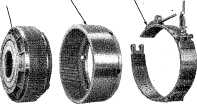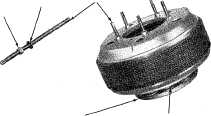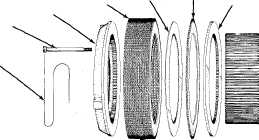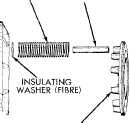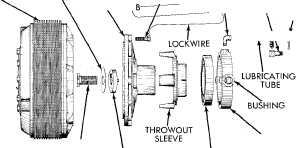remove, then remove the brake band lever. Do not remove the brake band as it will be used in lifting the steering clutch and brake drum assembly.
7. Remove the capscrews attaching the steering
clutch assembly to the driving hub and the
brake drum hub. This will necessitate turn-
ing the clutch assembly and brake drum
which can be accomplished by inserting a
suitable bar in one of the ventilating holes
in the brake drum.
clutch assembly to the driving hub and the
brake drum hub. This will necessitate turn-
ing the clutch assembly and brake drum
which can be accomplished by inserting a
suitable bar in one of the ventilating holes
in the brake drum.
8. Using a chain hooked around the brake band
adjuster and around a yoke pin placed in
the lower end of the band, lift the steering
clutch assembly and brake drum out of the
compartment as shown in Figure No. 1.
adjuster and around a yoke pin placed in
the lower end of the band, lift the steering
clutch assembly and brake drum out of the
compartment as shown in Figure No. 1.
from the top of the housing and pour about three gallons of solvent into each compartment. Drive the tractor back and forth in a straight line for approximately five minutes, leaving the steering clutches engaged. The oil on the exterior of the clutches and brakes will be washed off in this operation.
3. Drain the compartments and refill with the
same amount of solvent, then drive the trac-
tor back and forth for approximately another
five minutes, disengaging one clutch and
then the other continually during this period.
Disengaging the clutches allows the clutch
discs to separate so that the solvent can get
in between the discs to wash the oil from
their friction surfaces.
same amount of solvent, then drive the trac-
tor back and forth for approximately another
five minutes, disengaging one clutch and
then the other continually during this period.
Disengaging the clutches allows the clutch
discs to separate so that the solvent can get
in between the discs to wash the oil from
their friction surfaces.
4. Drain the compartments and allow the
clutches a short time to dry. Operate the
tractor with a light load in low gear until
the clutches become thoroughly dry, other-
wise they may slip due to the presence of
solvent on the discs.
clutches a short time to dry. Operate the
tractor with a light load in low gear until
the clutches become thoroughly dry, other-
wise they may slip due to the presence of
solvent on the discs.
ID. Clutch Removal.
1. Remove the fuel tank (refer to "FUEL TANK
REMOVAL" in Section II).
REMOVAL" in Section II).
2. Remove the center and rear floor plates.
3. Remove the jam nut, and the brake band
support adjusting nut.
support adjusting nut.
4. Remove the steering clutch compartment
covers.
covers.
5. Turn the brake band adjuster counter-clock-
wise untii it is loosened from the brake band
adjusting fork.
wise untii it is loosened from the brake band
adjusting fork.
6. Remove the yoke pin connecting the brake
rod yoke assembly to the brake band lever.
Remove the pipe plug located in the side of
the steering clutch case in line with the brake
band pin, and using a suitable 3/8" N.C.
capscrew inserted through the hole, turn it
into the tapped hole in the end of the pin.
Now pull the brake band adjusting fork pin
out and remove the brake band adjusting
fork. Lift up on the brake band lever until
the pin attaching the lower end of the band
to the lever, can be removed. Push the pin
towards the bevel gear compartment and
rod yoke assembly to the brake band lever.
Remove the pipe plug located in the side of
the steering clutch case in line with the brake
band pin, and using a suitable 3/8" N.C.
capscrew inserted through the hole, turn it
into the tapped hole in the end of the pin.
Now pull the brake band adjusting fork pin
out and remove the brake band adjusting
fork. Lift up on the brake band lever until
the pin attaching the lower end of the band
to the lever, can be removed. Push the pin
towards the bevel gear compartment and
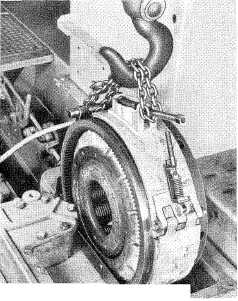
Vtl __ ..
Fig. 1—Removing Steering Clutch
I. Disassembly of Steering Clutches.
1, Remove the drum from the clutch assembly
being careful not to bend the clutch disc
teeth.
being careful not to bend the clutch disc
teeth.
2. Before disassembling the clutch, center punch
the pressure plate, the back plate, the hub,
and the throwout plate so that they can be
reassembled in the same position as they
were before disassembly.
the pressure plate, the back plate, the hub,
and the throwout plate so that they can be
reassembled in the same position as they
were before disassembly.
199
